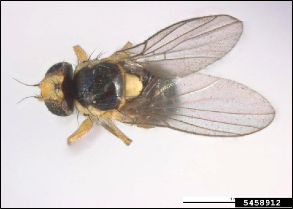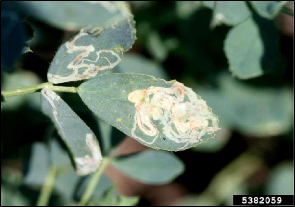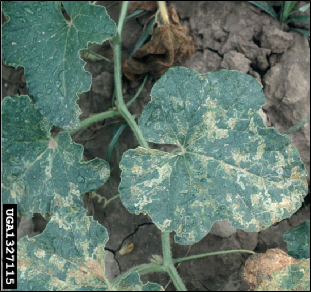Agromyzid Leafminers
ID
3104-1554 (ENTO-437NP)
Introduction
Agromyzid leafminers are small flies in the family Agromyzidae in the order Diptera. Many other insects, such as beetles, sawflies, moths, and other types of flies are also called leafminers. Agromyzid leafminers usually develop in leaf tissue, but some are stem miners while others form galls. This factsheet focuses on the leafmining agromyzid flies.
Description
Many species of agromyzid leafminers are small, yellow and black flies (Fig. 1), but some are grayish-black and others may have some green or blue coloration. Most adult agromyzid leafminer flies measure only several mm long. The tiny, white or yellow larvae have cylindrical bodies measuring up to 3 mm (0.13 inch) long.

Life History
Agromyzid leafminers have a complete life cycle of egg, larval, pupal, and adult stages. Females deposit eggs within living leaf tissues of host plants. Larvae hatch from eggs in a few days and begin feeding on internal leaf tissues (Fig. 2), leaving the upper and lower layers intact. The larvae create wider tunnels as they develop in size. Mature larvae either emerge from inside the leaf and drop to the soil where they pupate in soil crevices, or remain and pupate on the leaf. The time span from egg to adult is less than three weeks under optimum conditions, so multiple generations of these insects can develop over a summer.

Common Host Plants
Agromyzid leafminers have a broad host range of vegetable, weedy, and tree species. Vegetable hosts include tomato, pepper, celery, spinach, beans, peas, potato, squash, onion, melons, and pumpkin. Ornamental plants attacked by agromyzid leafminers include columbine, holly, chrysanthemum, and daylilies. Some agromyzid leafminers are plant-specific while others attack a wide range of plants.
Distribution
Agromyzid leafminers are found throughout the United States.
Damage
Larvae make long, winding, light-colored tunnels in leaves. Sometimes the mines coalesce into more blotchy shapes. Photosynthesis is reduced in heavily mined leaves (Fig. 3). Mines reduce the aesthetic value of ornamental plants. Damage usually is not appreciable in the northern states as the insects do not have as many generations as in the warmer, more southern states.

Cultural Control
Pick and destroy infested leaves when mines are seen to kill developing larvae.
Organic/Biological Control
Parasitic wasps naturally present in the landscape often control agromyzid leafminers.
Chemical Control
Treat with a labeled insecticide. For cucurbits such as cantaloupes, cucumber, squash, pumpkins, and watermelons, treat when damage appears and repeat as needed.
See the current treatment recommendations for leafminers in the Virginia Pest Management Guides for Home Grounds and Animals (VCE Publication 456-418) for home owners or the Horticulture and Forest Crops (VCE Publication 456-418) for floral and nursery crops. For commercial vegetable production, see the Mid- Atlantic Commercial Vegetable Recommendations (VCE Publication 456-420). As with all pesticides, follow the label instructions carefully with regards to rates and precautions.
Virginia Cooperative Extension materials are available for public use, reprint, or citation without further permission, provided the use includes credit to the author and to Virginia Cooperative Extension, Virginia Tech, and Virginia State University.
Virginia Cooperative Extension is a partnership of Virginia Tech, Virginia State University, the U.S. Department of Agriculture (USDA), and local governments, and is an equal opportunity employer. For the full non-discrimination statement, please visit ext.vt.edu/accessibility.
Publication Date
March 1, 2021



